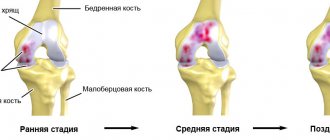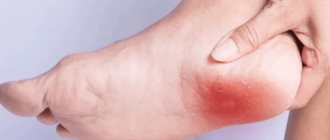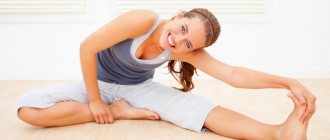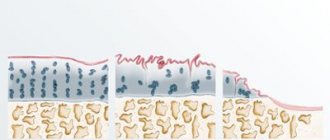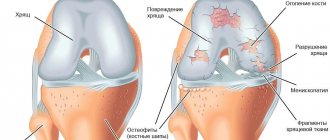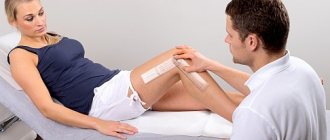In complex therapy for the treatment of knee arthrosis, ointments are used.
Diseases of the musculoskeletal system are treated comprehensively, so external agents are also used in conjunction with systemic medications. The question of which ointments for arthrosis of the knee joint are considered the most effective and are used in modern medicine needs to be considered in more detail.
The place of ointments in the treatment of arthrosis
Ointments are never prescribed as monotherapy - it is impossible to completely cure arthrosis with their help. The main task of ointments is to reduce the external manifestations of arthrosis, which bring suffering to the patient, and to some extent stop the progression of the destructive process in the joints.
Most ointments contain systemic substances, for example, non-steroidal anti-inflammatory substances, and are therefore used in short courses. After using them, the patient immediately notices positive dynamics:
- the inflammatory process subsides;
- Muscle tone decreases, spasm is eliminated;
- pain is relieved for a long time;
- blood supply to the joint is stabilized;
- the risk of infection is reduced;
- cartilage regeneration is accelerated.
On a note! Despite the fact that ointments are applied to the skin in the area of the affected joint, their active components penetrate into the bloodstream and have a slight systemic effect on the body.
What ointments are used for arthrosis
Ointment is a pharmaceutical product with a viscous consistency. It contains active substances with a pronounced therapeutic effect that are able to penetrate through the epidermis deep into the soft tissues.
Medicinal ointments used in the treatment of arthrosis may contain natural ingredients - bee venom, plant extracts, shark oil. These ointments include Ungapiven, Apizartron. They effectively stop inflammation in the joint and promote cartilage regeneration. A significant disadvantage of such ointments is the high risk of developing an allergic reaction.
The more common components of ointments for arthrosis are chemical components - diclofenac, nimesulide, ketoprofen. Ointments based on them relieve pain well, improve lymph flow, and slow down the inflammatory process.
Depending on the active substance and the therapeutic effect, all ointments are divided into several groups:
- NSAID-based ointments contain non-hormonal substances that have an anti-inflammatory effect. Indicated during the acute period of the disease. These include Diclak gel, Nise, Ketonal, Indomethacin.
- Capsaicin-based ointments. After application, they produce a warming effect, which causes a burning sensation in the joint. This group includes: Espol, Kapsin, Finalgon.
- Ointments with acetylsalicylic acid. They have local analgesic, anti-edematous and anti-inflammatory effects. These are Bom-Benge, Nizhvisal, Viprosal.
- Ointments with chondroprotective action. The active components penetrate the cartilage and restore it from the inside. This is Chondroitin, Arthro-Active.
- Ointments with natural ingredients. In the composition of remedies for arthrosis you can find vegetable and animal fats, vitamin and mineral supplements, and plant extracts. Ointments such as Traumeel S, Viprosal, and Vishnevsky ointment are effective.
Direction of action of drugs
Preparations for external use are characterized by a targeted local effect on the problem. With arthrosis, the cartilage tissue in the knee joint undergoes dystrophic-degenerative processes, gradually becomes thinner and exposes the bone heads, which is clearly visible on X-ray photographs or during MRI.
An x-ray will show changes that have occurred in the joint.
The ointments, gels and creams used must perform specific tasks. First of all, they are focused on eliminating the symptoms and causes of the disease, as well as restoring damaged tissue.
Directions of action of ointments for arthrosis:
- pain relief, creating a distracting effect;
- relief of the inflammatory process;
- warming up the knee;
- stimulation of blood circulation, improvement of tissue nutrition;
- restoration of cartilage lining;
- improvement of ligament elasticity indicators;
- restoration of motor ability of the joint;
- providing an antiseptic effect.
Features of the use of ointments for various types of arthrosis
Absolutely all ointments intended for the treatment of arthrosis can be used in the treatment of most groups of joints. There are no clear distinctions - a specific ointment for arthrosis of the fingers or a separate ointment for arthrosis of the hip joint. Any of them can be used, but taking into account the characteristics of the course of the disease, the presence of contraindications in the patient, and the body’s response to treatment.
What ointments are used for arthrosis of the knee joint
Osteoarthritis predominantly develops in large joints, especially the knees. Considering the fact that pain and stiffness in joint movements significantly reduces the quality of life, it is necessary to use ointments of complex action.
The most popular ointments for knee arthrosis contain NSAIDs. These non-hormonal substances relieve pain in the shortest possible time and make it possible to move fully. They can be used at the time of exacerbation of arthrosis, however, the duration of treatment is limited to 1-2 weeks.
NSAID-based ointments have many contraindications, including liver pathologies, a tendency to allergic manifestations, and skin diseases. For this reason, before applying the drug externally, you must carefully study the instructions.
Outside of an exacerbation, doctors recommend applying ointments with chondroprotectors, animal fats, and herbal ingredients to the affected knee. Treatment will help strengthen the cartilage and prevent arthrosis from completely destroying the joint.
Ointments for ankle arthrosis
Degenerative changes in the ankle and toes are as common as arthrosis of the knee. Treatment is carried out according to a similar algorithm, the list of ointments is the same. However, ointments for arthrosis of the foot and ankle do not always have the necessary effect. The load on these joints is so great that arthrosis progresses quickly and only one treatment option remains - joint replacement.
Most ointments for ankle injuries are used as an aid before or after surgery. As a rule, ointments with diclofenac or piroxicam are indicated for use, which can cope with the inflammatory reaction in the joint.
Ointments for arthrosis of the hip joint
Osteoarthritis of the hip joint is difficult to treat locally. The ointments that are prescribed to the patient must have good penetrating properties in order to be able to reach the target - the hip joint.
As a rule, ointments with NSAIDs are prescribed, which remove swelling and tenderness of tissues. However, if possible, this group of drugs is recommended to be taken orally - the analgesic and anti-inflammatory effect will be much stronger.
The use of ointments with a warming effect is also indicated. To enhance microcirculation and improve joint nutrition, ointments based on red pepper and bee venom are suitable.
Ointment for hand arthrosis
With the help of ointments, it is quite possible to alleviate the well-being of a patient who is faced with arthrosis of the fingers or shoulder joint. Arthrosis with this localization is characterized by a slow course, which makes it possible to control it well with the help of medications.
The “gold standard” in treatment is considered to be ointments with a restorative and warming effect. Along with the traditional use of ointments with diclofenac, the joint prescription of several groups of ointments and physiotherapy is practiced. For example, they practice the use of ultrasound treatment and chondroprotective ointments for arthrosis of the shoulder joint and small finger joints. Together, it is possible to achieve long-term remission.
- Effective ointment for arthritis of the fingers: review, application features and reviews
How to choose the right drug
In order to get rid of arthrosis and not harm your health, it is important to choose the right medications for therapy. Your attending physician should compile a list and prescribe dosages after carrying out diagnostic measures.
For a comprehensive impact on the problem, tablets and injections are prescribed together with ointments, the patient’s lifestyle and diet are adjusted, therapeutic exercises and various procedures are recommended.
As for the direct selection of ointments, either complex preparations or several products from different groups are used for treatment. During the period of exacerbation of the disease, it is necessary to maximize the impact on the problem, therefore anti-inflammatory gels with a warming effect, as well as chondoprotectors, are prescribed. After stopping the pathological process, you can limit yourself to natural-based chondoprotectors and dietary supplements that stimulate cartilage restoration, for example, Toad Stone.
Be sure to read the instructions for each medicine to make sure you have no contraindications, and also to clarify possible side effects.
Review of effective ointments for arthrosis
Many ointments for arthrosis are popular. Therefore, it is sometimes difficult to make a choice in favor of one ointment or another. In addition, all ointments have their own properties and are designed to eliminate a specific symptom. Therefore, let’s look at what good ointments are for arthrosis, how to use them, and whether there are any contraindications.
Ointments based on non-steroidal anti-inflammatory substances
Every patient diagnosed with arthrosis knows the abbreviation NSAIDs. This is the name of a whole group of substances (non-hormonal in nature!) with a pronounced anti-inflammatory effect. Most ointments for arthrosis contain precisely these substances, which determines their effectiveness. Let's briefly look at popular ointments.
- Diclofenac
Ointment with the same substance diclofenac. This ointment, which treats arthrosis, is applied to the affected joint up to 4 times a day. After the first use, pain and swelling begin to disappear.
The course of treatment, which rarely exceeds 3 weeks, relieves inflammation in the joint for a long time, exhibits a mild antirheumatic effect, and restores mobility to the joint. The ointment can cause local allergic reactions and is contraindicated during pregnancy and skin diseases.
- Ketorol
Ketorol in the form of an ointment can be used to treat osteoarthritis, all types of arthrosis, and synovitis. The ointment contains the substance ketorolac, which has strong analgesic properties. Due to the inhibition of prostaglandin production, the patient's swelling goes away, pain decreases, and a general improvement in well-being is observed.
The increased effectiveness of the ointment is ensured by the presence of dimethyl sulfoxide, which acts as a conductor of the main substance. Therefore, this ointment is used for arthrosis to treat large joints to which access is limited, for example, the hip and shoulder joints.
The ointment is applied several times a day to clean skin, the duration of therapy is determined only by the doctor. The ointment is not used if the patient has a history of angioedema, bronchospasm and other allergic reactions associated with NSAIDs.
- Ortofen
Ointment based on diclofenac sodium. After application to the joint area, the product quickly copes with the symptoms of arthrosis, in particular pain, stiffness, and a local increase in body temperature. During treatment, there is an activation of metabolism in the cartilage and a moderate antihistamine effect.
The course of treatment lasts 14 days. A pea-sized amount of ointment is rubbed into the skin three times a day. Longer use of the ointment provokes the development of adverse reactions - allergies, necrosis of the epidermis, skin pathologies.
- Medicines for arthrosis of the knee joint
- Nise
Multicomponent ointment with anti-inflammatory and mild warming effect. The composition includes nimesulide, menthol, as well as capsaicin and methyl salicylate. This drug can be classified as part of a new generation of NSAID drugs for arthrosis.
After application to the skin, local irritation of receptors occurs, increased blood flow and suppression of pain.
Ointment in an amount of 2 g is rubbed three times a day. The duration is set individually. The drug is not prescribed to persons with asthma and intolerance to salicylic acid.
Ointments for joint arthrosis with a warming effect
Ointments that warm the skin perfectly stimulate microcirculation, eliminate the distracting effect, and reduce pain. By activating blood flow and dilating blood vessels, the nutrition of the cartilage is restored, and the destruction and deformation of the joint is slowed down.
These ointments contain capsaicin, an extract of red pepper. They work well in combination with other drugs, enhancing their therapeutic effect.
- Espaul
After application, the ointment causes a strong burning sensation on the skin, which has a distracting effect. The warming effect is provided by capsaicin, which is effective not only for arthrosis, but also for radiculitis and tendon damage.
A small amount of ointment is applied to the skin and rubbed in. It is important to be careful not to get the ointment on the mucous membranes, which can cause a burn.
Espol is recommended to be applied three times a day for a decade. The ointment is prohibited for use in cases of asthma, renal failure, and glaucoma. Side effects include angioedema and contact eczema.
- Nicoflex
The product is made on the basis of capsicum extract and salicylic acid. The indication for use is severe pain due to arthrosis.
Applying ointment for arthrosis of the legs or arms provides a strong warming effect, which allows the muscles to relax and the blood vessels to dilate.
The ointment is not prescribed to persons who have an active inflammatory process, open wounds on the skin, or bronchial asthma.
For the first three days, Nicoflex is rubbed into the joint once a day, then the ointment is applied morning and evening for 7-10 days.
- Bab Benguet
The ointment contains menthol and methyl salicylate. The drug dilates capillaries, inhibits mediators of the inflammatory reaction, and has a local analgesic effect.
The ointment is applied to clean skin without visible damage. After application, the joint is insulated with a woolen bandage. The procedure is repeated 2-3 times a day.
The best ointments for arthrosis based on bee venom
Ointments containing bee venom can have an irritating effect on a joint affected by arthrosis. In this way, it is possible to remove pain, improve the elasticity of muscle fibers, and strengthen cartilage.
Despite the effectiveness of bee venom, before you buy an ointment with this component for arthrosis, you must rule out allergies to bee products. Cases of acute allergic reaction to bee venom, including anaphylactic shock, are often recorded.
- Apizartron
The composition is dominated by bee venom and the analgesic allyl isothiocyanate. The ointment is indicated for joint pain during exacerbation of arthrosis.
Apizartron is applied to dry skin in a circular motion until the joint becomes warm. It is recommended to use disposable gloves during the application process.
The ointment is contraindicated for allergy sufferers, as well as patients with kidney and liver pathologies, intolerance to bee products. Prescribed with caution to children aged 6 to 12 years.
- Viprosal
Complex ointment with viper venom, as well as salicylic acid and camphor. After application to the skin, it causes a strong feeling of burning and warmth and effectively eliminates pain.
The ointment should be used in accordance with the permissible dose. Twice a day, 1-2 teaspoons of ointment are rubbed into the skin until the pain stops.
The ointment is contraindicated for tuberculosis, asthma, whooping cough, and renal failure.
Terms of use
There are certain rules for using ointments for arthrosis. In order for them to have the maximum effect, they must be followed, but it is worth checking with your doctor for personal recommendations.
Basic rules for using ointments for joints:
- The product must be applied to clean, dry skin over the entire surface of the joint and surrounding area.
- If you have wounds or areas of skin inflammation, you should avoid using local medications, especially if they contain irritating components.
- The ointment should be applied on average 2 times a day, optimally in the morning and evening. If the product has a specific smell, use it after work and just before bed.
- The duration of treatment depends on the stage of arthrosis, the type of medications used and the body’s reaction. To prevent addiction, it is worth taking breaks if long-term treatment is necessary or changing the ointment to a product with another active ingredient with similar properties.
You can get more information about the types and properties of ointments used for the treatment and prevention of arthrosis of the knee joints by watching the video in this article.
Treatment of arthrosis with ointment - reviews
From the practical experience of patients with arthrosis, the following conclusions can be drawn.
Vladimir, 42 years old, Ufa:
“I have deforming arthrosis of the right knee. I tried many ointments and tablets, which brought only temporary relief. Ultimately, the doctor recommended rubbing Capsicam ointment into the knee. The product helps a lot, and the price is very affordable.”
Oleg, 34 years old, Moscow:
“Two years ago I began to notice that my fingers were crunching strangely. Soon pain and inflammation appeared, I had to go to the doctor. I was diagnosed with arthrosis. Now I am being treated with Viprosal ointment. The pain began to subside, the bumps decreased a little, but the crunch remained. So far it helps. We'll see later."
Igor, 24 years old, Moscow:
“I’m a professional football player, so the load on my leg joints is enormous. Sometimes the pain and tension in the ankle and knee joints is so severe that I can’t even sleep. Recently, a routine examination by an orthopedist showed the initial stage of arthrosis of the left ankle joint. Now I’m taking a course of injections and rubbing Nise ointment at home. I can already feel the results, I hope I will be able to overcome arthrosis completely.”

